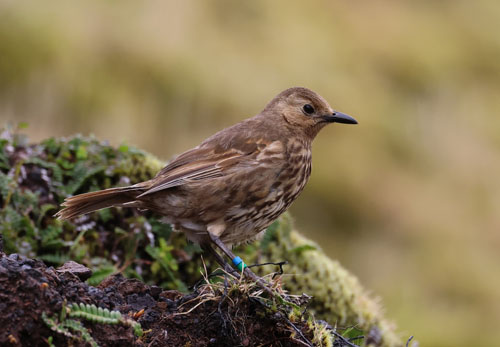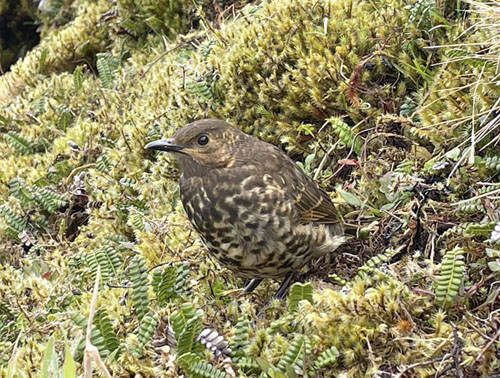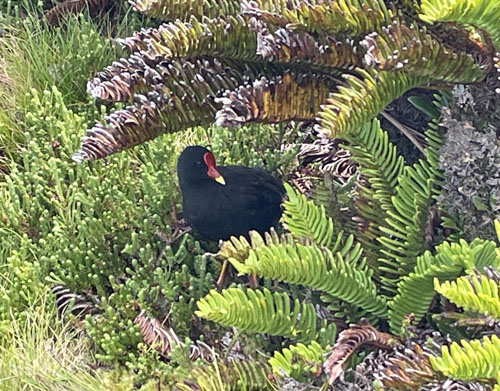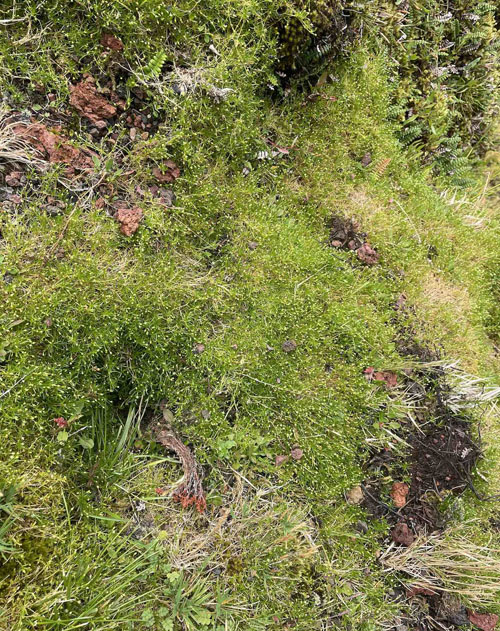Tristan Starchy Survey uncovers mountain Sagina spread
Report and photos from Peter Ryan
Emeritus Professor, FitzPatrick Institute of African Ornithology, University of Cape Town

One of 16 Starchies ringed on Tristan during the survey

The only juvenile Tristan Thrush or Starchy seen during the survey
Starchy and Gough Moorhen survey on Tristan
The Tristan Thrush or Starchy is the only native landbird that survives on the main island of Tristan; the native finch and flightless moorhen both went extinct in the 19th Century. The thrush on Tristan is smaller and paler than on Inaccessible and Nightingale Island, and is recognised as a distinct subspecies. It is much more scarce on Tristan than on the other islands, but there has been little attempt to estimate their abundance and distribution. Peter Ryan and Coleen Moloney returned to Tristan in February-March 2024 to estimate the population of Starchies and Gough Moorhens. Starchies occur in low densities in Phylica woodland along the coastal cliffs, and locally at some of the gulches on the base, but are most common on the lower slopes of the peak above 1100 m. Worryingly, very few juveniles were observed, suggesting that breeding success is poor.

A Gough Moorhen peers out from under a bogfern on the Base above Burntwood
Gough Moorhens were introduced at Sandy Point on Tristan in 1956, when the Gough Island Scientific Survey team returned to Tristan. It is fascinating to speculate why they have flourished while the flightless moorhen native to Tristan went extinct. Peter and Coleen conducted repeated counts at 94 sites right around Tristan which show that moorhens occur in all areas with sufficient cover from the coast to around 900m elevation. The count data will be used by the RSPB to estimate the current population.

Sagina can displace more palatable plant species, reducing forage for sheep
Procumbent Pearlwort on the Peak
While searching for Starchies (Tristan Thrushes), Peter Ryan came across large areas of Procumbent Pearlwort (Sagina procumbens) near the Castles between 1150 and 1300 m on the lower slopes of Tristan’s peak. Subsequently it was also found east of Hottentot Gulch at a similar elevation. This invasive species is commonly found in stony areas on the coastal lowlands of Tristan, with large areas at The Caves particularly badly affected. However, to date it has not been reported from the island’s interior. It’s presence on the Peak is particularly worrying, because the Pearlwort is an aggressive invader of loose scoria, and so has the potential to radically change the vegetation of the peak. Sadly there’s little that can be done to prevent its spread. A massive effort to eradicate the plant on Gough Island, where it was introduced at the weather station in the late 1990s, was finally abandoned, with efforts now focusing on containing it to the sea cliffs in the immediate vicinity of the base. The fact that the Pearlwort has reached the peak on Tristan again raises concern about the possibility of it getting into the highlands of Gough, where it would likely have a much greater impact than in the lowlands. It also highlights the need for effective biosecurity measures even when moving around within as well as between islands.

Patch of Sagina on the upper Tristan slopes.
